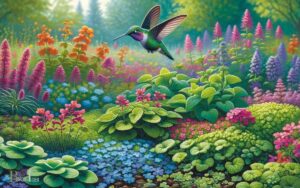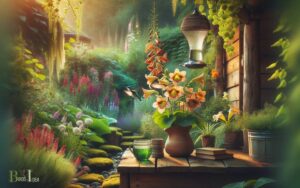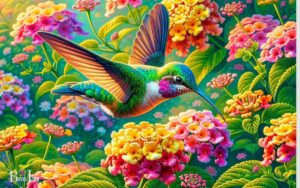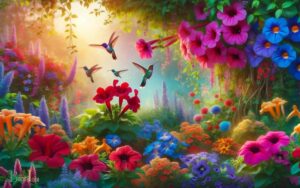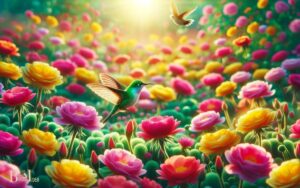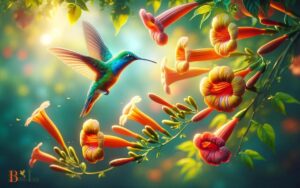Are Hummingbirds Attracted to Red? Yes!
Yes, hummingbirds are attracted to the color red. The vibrant red hue is highly visible to them, as hummingbirds have excellent color vision.
Red is often associated with nectar-rich flowers, a primary food source for these birds. Many hummingbird feeders also incorporate red components, such as red plastic or red dye, to attract them.
Additionally, the red color signals the presence of a potential food source, prompting hummingbirds to investigate and feed.
It is essential to maintain clean and well-filled feeders to consistently attract these remarkable birds.

Key Takeaway
Hummingbird Vision and Color Perception
The hummingbird’s vision and color perception play a crucial role in their attraction to red flowers. Hummingbirds are known to have excellent color vision, particularly in the red spectrum.
They possess a high density of cone cells in their retinas, with a specific sensitivity to long wavelengths of light, making them especially responsive to red hues.
This enables them to distinguish various shades of red, allowing them to easily spot red flowers from a distance.
Additionally, their ability to perceive ultraviolet light further enhances their color vision, aiding in the detection of nectar guides on flowers.
The combination of keen color perception and ultraviolet sensitivity makes red flowers stand out prominently to hummingbirds, guiding them to an abundant source of nectar.
Understanding the intricate visual abilities of hummingbirds sheds light on their strong attraction to red blooms.
Red in Nature: A Signal for Nectar
A Signal for Nectar’, exploring the significance of red as a signal for nectar in the natural world.
In the natural world, red is a signal for nectar, particularly in the context of flowering plants. Many flowers that rely on animal pollinators, including hummingbirds, have evolved to display red coloration as a means of attracting these animals.
The color red serves as a visual cue for nectar-seeking animals, including hummingbirds, as it contrasts against the surrounding green foliage and is easily distinguishable to these creatures.
This association between red and nectar has likely influenced the evolution of hummingbird vision and color preferences.
Understanding the role of red as a signal for nectar is essential in comprehending the foraging behaviors of hummingbirds.
The Role of Red in Hummingbird Mating
Red coloration plays a crucial role in signaling reproductive fitness and mate attraction among hummingbirds.
The role of red in hummingbird mating can be understood through the following key points:
- Male Displays: Male hummingbirds use red plumage to display their fitness and attract potential mates. The vibrant red coloration is a signal of health and genetic quality, which is essential for successful reproduction.
- Female Choice: Female hummingbirds are more likely to choose mates with intense red coloration, as it indicates the male’s ability to acquire necessary resources and provide for offspring.
- Territorial Defense: Red throat patches or gorgets are used by male hummingbirds to establish and defend territories. This behavior showcases their dominance and ability to secure resources, making them more attractive to potential mates.
- Courtship Rituals: Red plays a significant role in the elaborate courtship displays of male hummingbirds, where they use their colorful plumage to woo females and demonstrate their suitability as mates.
Understanding Hummingbird Feeder Color Preferences
Hummingbirds demonstrate distinct color preferences when selecting feeder options, often showing a strong attraction to certain hues.
This preference for particular colors can be linked to their natural foraging behaviors and visual perception.
Research suggests that hummingbirds are particularly attracted to the colors red, orange, and pink, as these hues resemble the vibrant, nectar-rich flowers they feed on in the wild.
These colors are easily visible to hummingbirds due to their trichromatic vision, which allows them to perceive a wide spectrum of colors.
Additionally, the color red is associated with high energy and is known to stimulate foraging behavior in hummingbirds.
Understanding these color preferences is crucial for designing effective hummingbird feeders that attract and cater to the visual needs of these remarkable avian creatures.
Tips for Attracting Hummingbirds With Red
Effective ways to attract hummingbirds with the color red include incorporating red elements into the garden and selecting red-hued feeders.
Here are some tips for attracting hummingbirds with red:
- Plant red flowers such as bee balm, trumpet vine, or cardinal flower to attract hummingbirds to the garden.
- Use red-colored feeders that are easy for hummingbirds to spot and visit.
- Hang red ribbons or wind chimes near the feeding area to catch the attention of hummingbirds.
- Avoid using pesticides in the garden, as they can be harmful to hummingbirds and other wildlife.
Conclusion
The color red plays a significant role in attracting hummingbirds due to their unique vision and color perception.
It serves as a signal for nectar in nature and plays a role in their mating rituals. Understanding the importance of red in attracting hummingbirds can help in choosing the right feeder colors.
By incorporating red into the environment, one can symbolically invite these fascinating creatures to their space and enjoy their presence.

